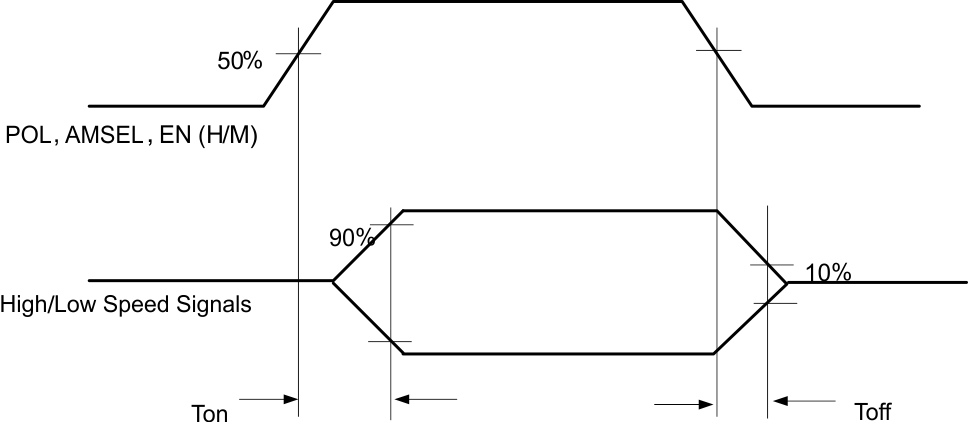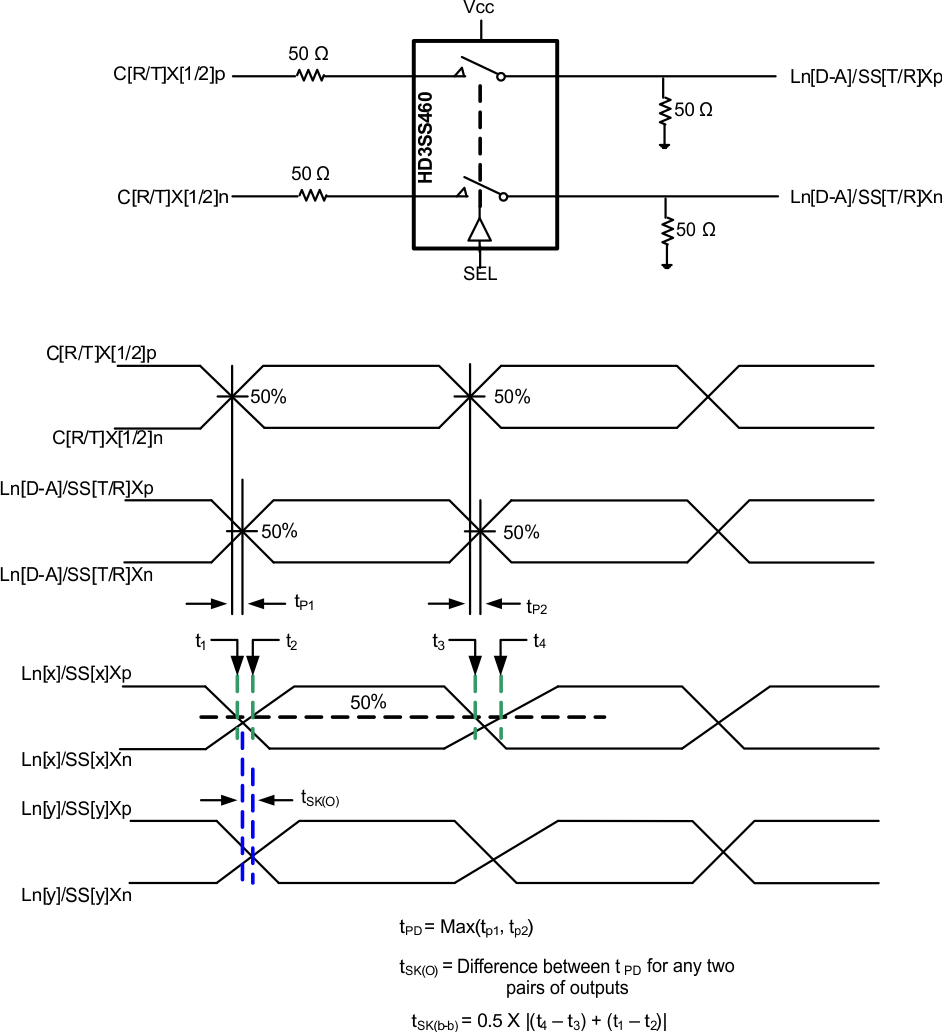SLLSEM7D January 2015 – January 2017 HD3SS460
PRODUCTION DATA.
- 1 Features
- 2 Applications
- 3 Description
- 4 Revision History
- 5 Device Comparison Table
- 6 Pin Configuration and Functions
- 7 Specifications
- 8 Detailed Description
- 9 Application and Implementation
- 10Power Supply Recommendations
- 11Layout
- 12Device and Documentation Support
- 13Mechanical, Packaging, and Orderable Information
7 Specifications
7.1 Absolute Maximum Ratings
over operating free-air temperature range (unless otherwise noted) (1)
(1) Stresses beyond those listed under Absolute Maximum Ratings may cause permanent damage to the device. These are stress ratings only, which do not imply functional operation of the device at these or any other conditions beyond those indicated under Recommended Operating Conditions. Exposure to absolute-maximum-rated conditions for extended periods may affect device reliability.
7.2 ESD Ratings
| VALUE | UNIT | |||
|---|---|---|---|---|
| V(ESD) | Electrostatic discharge | Human-body model (HBM), per ANSI/ESDA/JEDEC JS-001(1) | ±4000 | V |
| Charged-device model (CDM), per JEDEC specification JESD22-C101(2) | ±1000 | V | ||
(1) JEDEC document JEP155 states that 500-V HBM allows safe manufacturing with a standard ESD control process. Manufacturing with less than 500-V HBM is possible with the necessary precautions.
(2) JEDEC document JEP157 states that 250-V CDM allows safe manufacturing with a standard ESD control process. Manufacturing with less than 250-V CDM is possible with the necessary precautions.
7.3 Recommended Operating Conditions
over operating free-air temperature range (unless otherwise noted)7.4 Thermal Information
| THERMAL METRIC(1) | HD3SS460 | UNIT | ||
|---|---|---|---|---|
| QFN (RNH) | QFN (RHR) | |||
| 30 PINS | 28 PINS | |||
| RθJA | Junction-to-ambient thermal resistance | 51.6 | 44.0 | °C/W |
| RθJC(top) | Junction-to-case (top) thermal resistance | 37.5 | 34.8 | °C/W |
| RθJB | Junction-to-board thermal resistance | 17.5 | 14.7 | °C/W |
| ψJT | Junction-to-top characterization parameter | 0.7 | 0.7 | °C/W |
| ψJB | Junction-to-board characterization parameter | 17.3 | 24.5 | °C/W |
| RθJC(bot) | Junction-to-case (bottom) thermal resistance | 6.8 | 6.9 | °C/W |
(1) For more information about traditional and new thermal metrics, see the Semiconductor and IC Package Thermal Metrics application report.
7.5 Electrical Characteristics
typical values for all parameters are at VDD = 3.3 V and TA = 25°C (unless otherwise noted)7.6 High Speed Port Performance Parameters
under recommended operating conditions; RLOAD, RSC = 50 Ω (unless otherwise noted)| PARAMETER | MIN | TYP | MAX | UNIT | ||
|---|---|---|---|---|---|---|
| RL | Differential return loss | 100 Mhz SS Paths | –23 | dB | ||
| 2.5 Ghz SS Paths | –9 | |||||
| 100 MHz AM Paths | –23 | |||||
| 2. 7GHz AM Paths | –13 | |||||
| IL | Differential insertion loss | 100 Mhz SS Paths | –0.7 | |||
| 2.5 Ghz SS Paths | –1.6 | |||||
| 100 MHz AM Paths | –0.7 | |||||
| 2.7 GHz AM Paths | –1.4 | |||||
| OI | Differential off isolation | 100 Mhz | –50 | |||
| 2.5 Ghz | –26 | |||||
| 2.7 GHz | –25 | |||||
| Xtalk | Differential cross talk, Between CRX1/2 and CTX1/2 | 100 Mhz | –80 | |||
| 2.5 Ghz | –30 | |||||
| 2.7 Ghz | –28 | |||||
| Differential cross talk, Between CRX1 and CRX2 or CTX1 and CTX2 | 100 Mhz | –50 | ||||
| 2.5 Ghz | –26 | |||||
| 2.7 Ghz | –25 | |||||
| BWSS | Differential –3 dB BW SS Paths | 4.2 | GHz | |||
| BWAM | Differential –3 dB BW AM Paths | 5.4 | ||||
| BWSBU | Low-speed switch –3 dB BW | 500 | MHz | |||
7.7 High Speed Signal Path Switching Characteristics
| PARAMETER | TEST CONDITION | MIN | TYP | MAX | UNIT | |
|---|---|---|---|---|---|---|
| tPD | Switch propagation delay | RSC and RLOAD = 50 Ω, Figure 2 | 100 | ps | ||
| tSK(O) | Inter-Pair output skew (CH-CH) | 50 | ||||
| tSK(b-b) | Intra-Pair output skew (bit-bit) | 5 | ||||
| tON | Control signals POL, AMSEL and EN (H/M toggle) to switch ON time | RSC and RLOAD = 50 Ω, Figure 1 | 3 | µs | ||
| tOFF | Control signals POL, AMSEL and EN (H/M toggle) to switch OFF time | 1 | ||||
7.8 Timing Diagrams
 Figure 1. Switch ON/OFF Time
Figure 1. Switch ON/OFF Time
 Figure 2. Propagation Delay and Skew
Figure 2. Propagation Delay and Skew